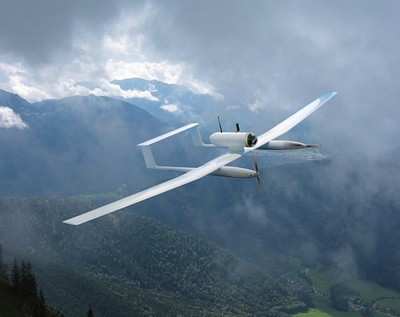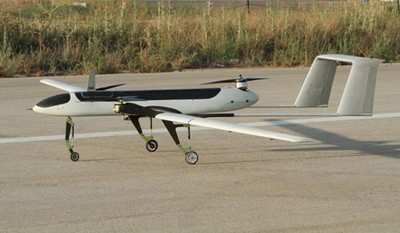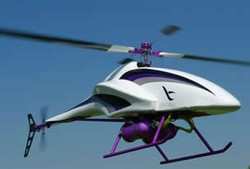MIT Researchers Find Critical Speed Above Which Birds —
And Drones — Are Sure To Crash
The northern goshawk is one of nature’s diehard
thrill-seekers. The formidable raptor preys on birds and small
mammals, speeding through tree canopies and underbrush to catch its
quarry. With reflexes that rival a fighter pilot’s, the
goshawk zips through a forest at high speeds, constantly adjusting
its flight path to keep from colliding with trees and other
obstacles.
UAV File Photo

While speed is a goshawk’s greatest asset, researchers at
MIT say the bird must observe a theoretical speed limit if it wants
to avoid a crash. The researchers found that, given a certain
density of obstacles, there exists a speed below which a bird
— and any other flying object — has a fair chance of
flying collision-free. Any faster, and a bird or aircraft is sure
to smack into something, no matter how much information it has
about its environment. A paper detailing the results has been
accepted to the IEEE Conference on Robotics and Automation.
These findings may not be news to the avian world, but Emilio
Frazzoli, an associate professor of aeronautics and astronautics at
MIT, says knowing how fast to fly can help engineers program
unmanned aerial vehicles (UAVs) to fly at high speeds through
cluttered environments such as forests and urban canyons.
Frazzoli is part of an interdisciplinary team that includes
biologists at Harvard University, who are observing flying
behaviors in goshawks and other birds, and roboticists at MIT, who
are engineering birdlike UAVs. With Frazzoli’s mathematical
contributions, the team hopes to build fast, agile UAVs that can
move through cluttered environments — much like a goshawk
streaking through the forest.
Most UAVs today fly at relatively slow speeds, particularly if
navigating around obstacles. That’s mainly by design:
Engineers program a drone to fly just fast enough to be able to
stop within the field of view of its sensors. "If I can only see up
to five meters, I can only go up to a speed that allows me to stop
within five meters,” Frazzoli says. “Which is not very
fast.”
UAV File Photo

If the northern goshawk flew at speeds purely based on what it
could immediately see, Frazzoli conjectures that the bird would not
fly as fast. Instead, the goshawk likely gauges the density of
trees, and speeds past obstacles, knowing intuitively that, given a
certain forest density, it can always find an opening through the
trees.
Frazzoli points out that a similar intuition exists in downhill
skiing. “When you go skiing off the path, you don’t ski
in a way that you can always stop before the first tree you
see,” Frazzoli says. “You ski and you see an opening,
and then you trust that once you go there, you’ll be able to
see another opening and keep going.”
Frazzoli says that in a way, robots may be programmed with this
same speedy intuition. Given some general information about the
density of obstacles in a given environment, a robot could
conceivably determine the maximum speed below at it can safely fly.
Toward this end, Frazzoli and PhD student Sertac Karaman developed
mathematical models of various forest densities, calculating the
maximum speed possible in each obstacle-filled environment.
The researchers first drew up a differential equation to
represent the position of a bird in a given location at a given
speed. They then worked out what’s called an ergodic model
representing a statistical distribution of trees in the forest
— similar to those commonly used by ecologists to
characterize the density of a forest. In an ergodic forest, while
the size, shape and spacing of individual trees may vary, their
distribution in any given area is the same as any other area. Such
models are thought to be a fair representation of most forests in
the world.
UAV File Photo

Frazzoli and Karaman adjusted the model to represent varying
densities of trees, and calculated the probability that a bird
would collide with a tree while flying at a certain speed. The team
found that, for any given forest density, there exists a critical
speed above which there is no “infinite collision-free
trajectory.” In other words, the bird is sure to crash. Below
this speed, a bird has a good chance of flying without incident.
“If I fly slower than that critical speed, then there is a
fair possibility that I will actually be able to fly forever,
always avoiding the trees,” Frazzoli says.
The team’s work establishes a theoretical speed limit for
any given obstacle-filled environment. For UAVs, this means that no
matter how good robots get at sensing and reacting to their
environments, there will always be a maximum speed they will need
to observe to ensure survival. The researchers are now seeing if
the theory bears out in nature. Frazzoli is collaborating with
scientists at Harvard, who are observing how birds fly through
cluttered environments — in particular, whether a bird will
choose not to fly through an environment that is too dense. The
team is comparing the birds’ behavior with what
Frazzoli’s model can predict. So far, Frazzoli says
preliminary results in pigeons are “very
encouraging.”
In the coming months, Frazzoli also wants to see how close
humans can come to such theoretical speed limits. He and his
students are developing a first-person flying game to test how well
people can navigate through a simulated forest at high speeds.
“What we want to do is have people play, and we’ll
just collect statistics,” Frazzoli says. “And the
question is, how close to the theoretical limit can we
get?”
 ANN's Daily Aero-Linx (05.06.25)
ANN's Daily Aero-Linx (05.06.25) ANN's Daily Aero-Term (05.06.25): Ultrahigh Frequency (UHF)
ANN's Daily Aero-Term (05.06.25): Ultrahigh Frequency (UHF) ANN FAQ: Q&A 101
ANN FAQ: Q&A 101 Classic Aero-TV: Virtual Reality Painting--PPG Leverages Technology for Training
Classic Aero-TV: Virtual Reality Painting--PPG Leverages Technology for Training Airborne 05.02.25: Joby Crewed Milestone, Diamond Club, Canadian Pilot Insurance
Airborne 05.02.25: Joby Crewed Milestone, Diamond Club, Canadian Pilot Insurance





